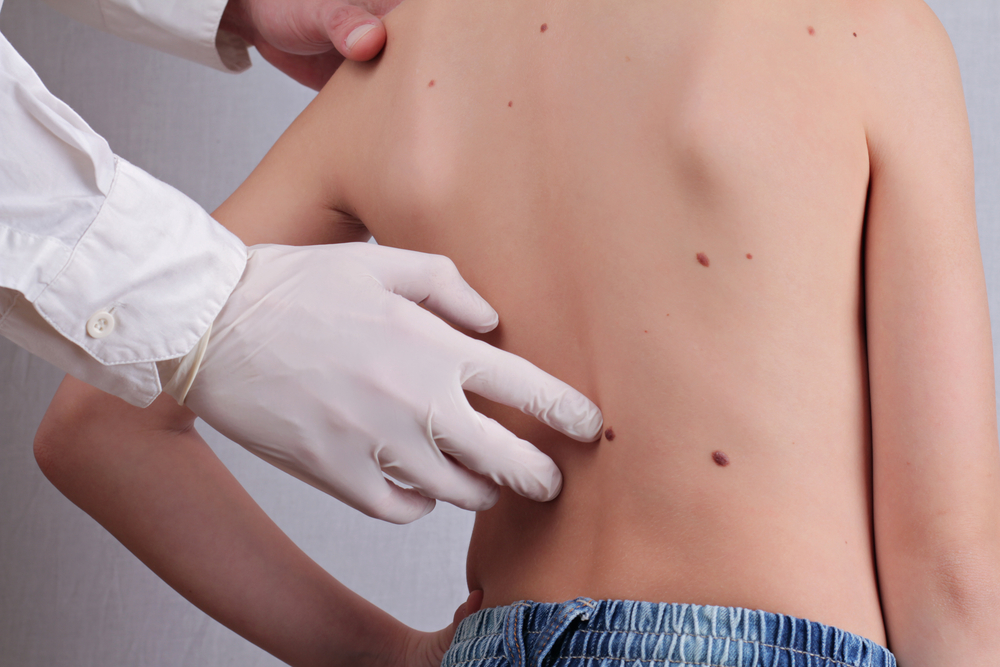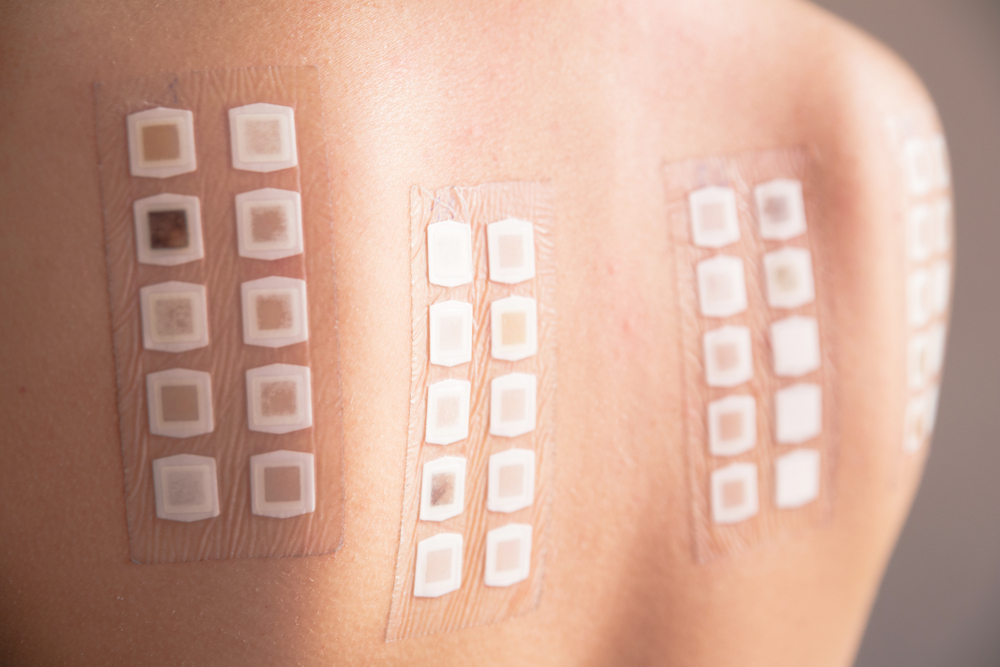- Melanoma is a form of cancer caused by the mutation or pigment-producing cells in the skin.
- Pediatric melanoma is the most common skin cancer in children.
- The symptoms for pediatric melanoma differ from those found in adults.
- Melanoma is curable if caught early enough, which is why regular examinations and preventative measures are key.
Most moles appear as skin marks that never become cancerous or pose any sort of health danger, even if they may be a bit unsightly from a cosmetic perspective. In some cases, however, moles develop into a type of skin cancer known as melanoma.
Both adults and children of all ages can develop melanoma. Early diagnosis is critical to eradicating the cancer before it spreads, and parents should regularly examine their children as well as themselves.
Read on to find out what symptoms you should be looking if your child has a suspicious looking mole.
What is pediatric melanoma?
Melanoma is a type of skin cancer that occurs when melanocytes, or pigment-producing cells, mutate and become cancerous. Pediatric melanoma is the most common skin cancer in children, with between 300 and 500 new cases diagnosed in the United States each year.
In children, about 40 percent of melanomas arise from a congenital melanocytic nevus (plural: nevi) that is present at birth, making it the most common type of pediatric melanoma.
Pediatric melanoma in children and teenagers falls into three categories:
- Congenital Melanocytic Nevus (CNM): These large, pigmented moles or birthmarks are present at birth. Research suggests approximately 5-10 percent of CNM cases develop into melanoma.
- Conventional Melanoma (CM): As the name suggests, this type bears similarities to adult melanoma, including signs of DNA damage caused by UV rays.
- Spitzoid Melanoma (SM): These nodes are round in shape and uniform in color, contrasting common signs of adult melanoma (i.e., irregular shape and color).
“Just because you are born with a mole, called a congenital nevus, does not mean it is safe for life. In fact, congenital nevi actually have an increased risk of melanoma over the course of your lifetime,” explains Dr. Janet Prystowsky, a board-certified dermatologist with over 30 years of experience in dermatology and dermatologic surgery.
If caught early, melanoma is very treatable and can often be cured or removed via surgery. However, melanoma in children may go unrecognized or be misdiagnosed, since the symptoms in children differ from those found in adults.
Symptoms of pediatric and adolescent melanoma
The five main signs of adult and teenage melanoma follow the mnemonic ABCDE: asymmetry, irregular borders, dark or variegated colors, a diameter larger than a pencil eraser (or 6 mm), and evolution or change over time.
Use these signs when checking your adolescent child for suspicious moles.
However, if your child is 10 or younger, you’ll need to look for slightly different signs in addition to those listed above. For example, melanomas in adults often turn darker, whereas in children they may be whitish, yellowish, or pink.
According to the Melanoma Research Foundation, there are six main symptoms of pediatric melanoma to look for in children under 10 years:
- A bump that itches and bleeds
- A spot that looks like an unusual wart, which may be skin-colored (non-pigmented) or a pinkish color
- A lump on the skin that is not dark or black (a.k.a. an amelanotic lesion)
- A mole that becomes very bumpy and sticks out far from the skin
- Any lesion or lump, especially one that has been growing rapidly
- Any strange and/or large moles, especially one that has multiple colors or looks different from your child’s other moles
Several factors can increase your child’s risk of developing melanoma, including fair skin, a history of blistering sunburns, and several large or many small moles. In addition, if you have a family history of either unusual moles or melanoma, you should be extra vigilant about checking your child for potential signs of pediatric melanoma.
When to worry about moles
Plenty of both adults and children are born with or develop moles that never turn cancerous, and not every mole is automatically suspicious. That being said, if your child has a bump that itches or bleeds, you should have a dermatologist examine it.
If the mole or mark is irregularly shaped or has multiple colors, that could also be a warning sign. Melanoma is not always dark-colored in children, so keep your eyes open for skin-colored moles and lumps, which can be harder to spot.
Perhaps the most important sign to look for is rapid change, whether that’s in size, shape, color, or elevation. These changes are caused by the cells mutating at an abnormally fast pace that does not occur under normal circumstances. Non-cancerous moles don’t usually change in appearance, at least not as quickly.
“Parents should bring their child to a dermatologist if they spot a mole or growth that has been changing or that looks different from all the others, or if a growth is bleeding, itching or looks irregular,” says Dr. Suzanne Friedler, a board-certified fellow of the American Academy of Dermatology and a clinical instructor at Mt. Sinai Medical Center.
Regularly examining your child for signs of potentially cancerous moles is an excellent way to spot symptoms. It will also help your child build a lifelong healthy habit and teach them the importance of regular self-examinations in general — not to mention that it’s a great reminder for you to examine yourself for signs of skin cancer, as well.
Melanoma doesn’t only occur on skin that’s exposed to the sun, so be sure to examine your child’s scalp, hands, bottom, and feet.
Course of treatment
If possible, seek out a dermatologist who has experience working with children. If your pediatric dermatologist examines the mole and determines that it looks suspicious, he or she will likely take a tissue sample and send it off for a biopsy.
If the biopsy comes back positive, there are several options for removing or treating the cancerous mole.
“The staging of the melanoma will determine the treatment course. The earlier you catch a melanoma the better,” Dr. Friedler says. “An in-situ or stage 0 melanoma has 100 percent cure rate, while a late-stage melanoma has a very poor prognosis.”
In fact, children with melanoma often fare well, especially if the cancer is caught in the early stages. For children and young adults with melanoma, the overall five-year survival rate is 90 percent. Surgery is the most common treatment option, which removes the diseased mole and any tissue that the cancer has spread to.
“Occasionally parents will have a plastic surgeon do the biopsy or excision because they want to minimize scarring for their child. But a plastic surgeon may or may not be familiar with Spitz nevi and other forms of pediatric melanoma,” Dr. Prystowsky notes. “Make sure you get a copy of your child’s pathology report so you can review the results with your pediatrician and determine if anything else is necessary.”
If the cancer has spread to the lymph nodes, chemotherapy and/or radiation therapy might be needed. Immunotherapy, which stimulates the patient’s immune system to attack the cancer cells on its own, is also an option.
Prevention tips
Sun exposure, and the resulting damage to the skin from UV rays, is a known risk factor for developing melanoma. The UV rays can damage DNA, leading the mole’s cells to become cancerous and begin mutating.
Limiting your child’s sun exposure — or your teen’s time spent in tanning beds — will cut down on their risk of developing melanoma now and later in life.
When possible, try to avoid the sun’s most intense rays from 10 a.m. to 2 p.m. Make sure your child has adequate sun protection no matter the activity — not just at the beach or pool, but also while playing sports, camping, or just making a trip to the local park. Use broad-spectrum, water-and-sweat-resistant sunscreen and reapply it according to the product’s directions.
When it comes to melanoma prevention habits, one of the best things you can do is set a good example for your child. Use plenty of sunscreen yourself, avoid the sun’s most intense rays as well as tanning beds, wear hats and UV-protection sunglasses outside, and regularly examine yourself for suspicious moles.
While pediatric melanoma may be one of the most common cancers among children, its prognosis is very good if caught early enough. Examine your child regularly, and make sure he or she is protected from UV exposure.
» If you think your child has a suspicious mole that needs to be checked out by a professional, our medical review team can help you by addressing your concerns and providing appropriate recommendations.









